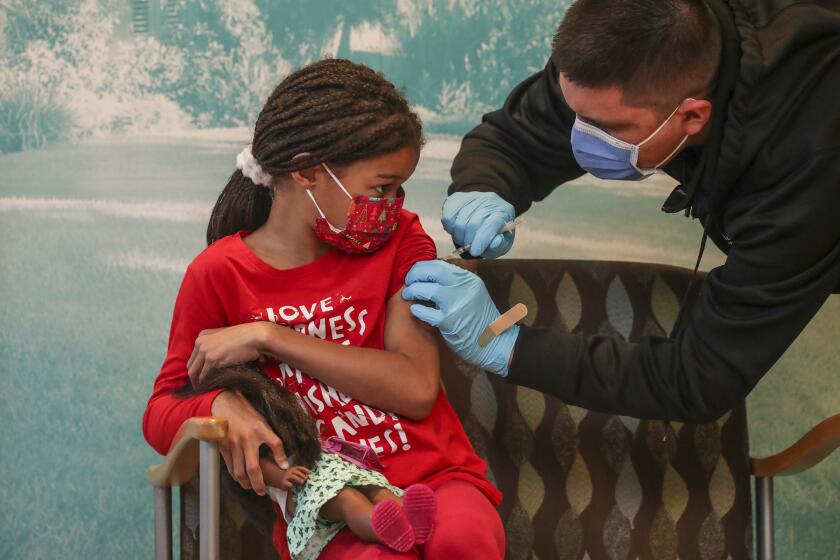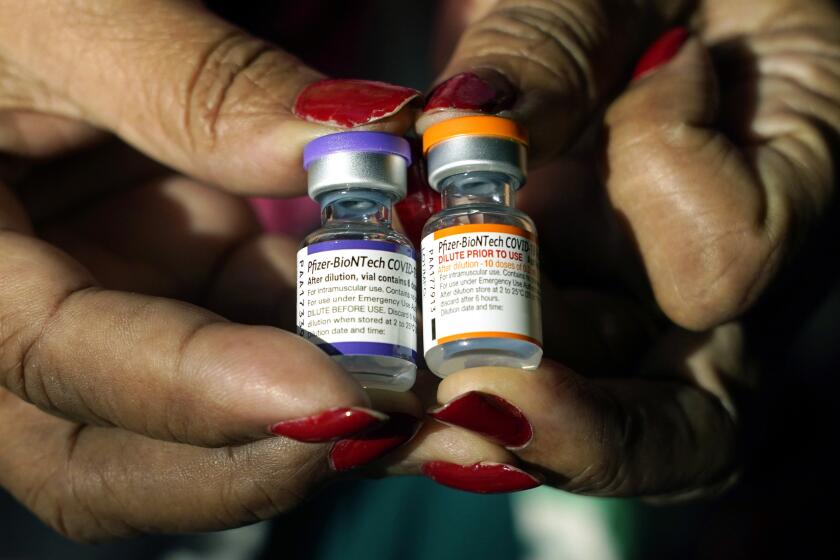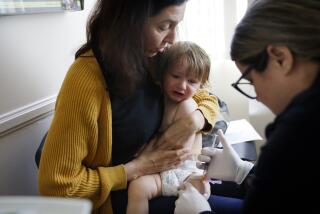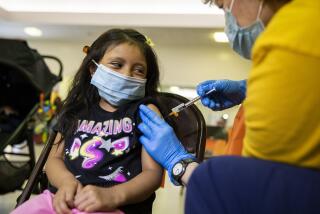How effective are COVID-19 vaccines for children 5-11? New data offer some answers
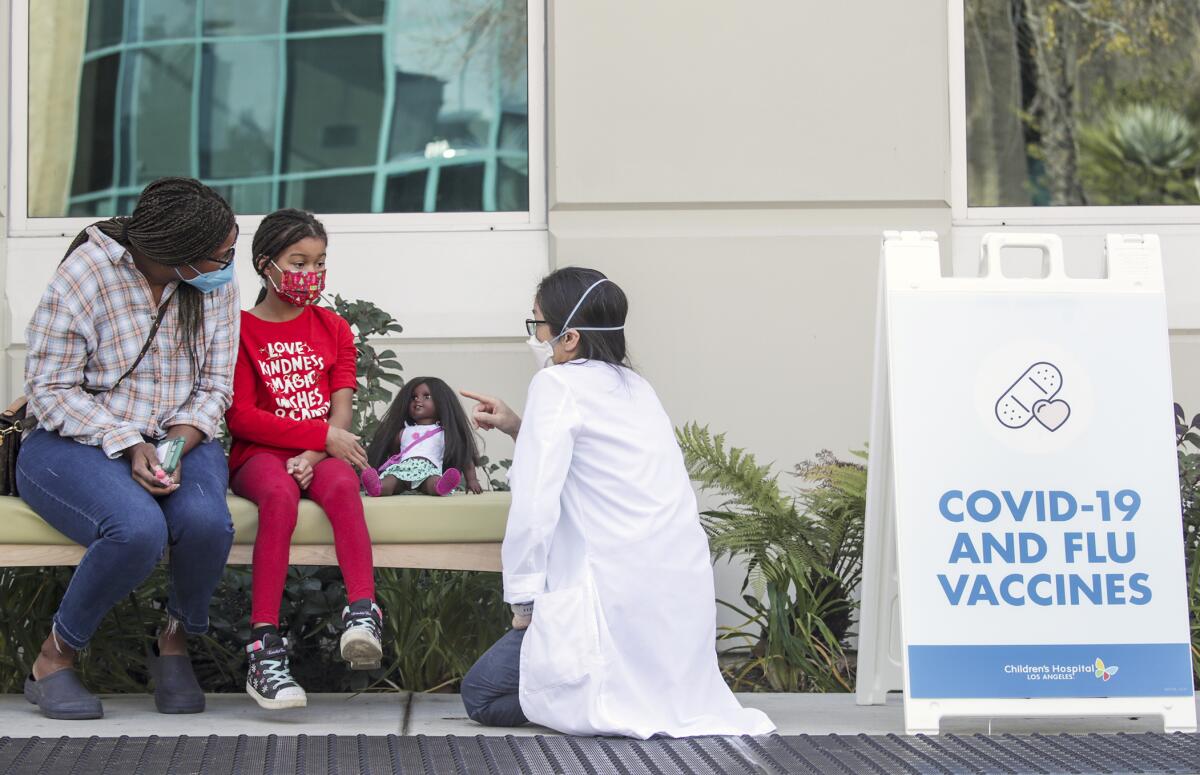
- Share via
So how effective are COVID-19 vaccinations for children age 5 to 11?
There are emerging data suggesting that protection against infection wanes for vaccinated children in this age group. But that shouldn’t be a surprise, some experts say, as vaccination series without a booster shot generally have been less effective in protecting against infection from the Omicron variant of the coronavirus than earlier strains, and children in this age group aren’t eligible for a booster.
Promising new data
The good news is that recent data — a study from the New York State Department of Health that hasn’t been peer reviewed, and a report published by the U.S. Centers for Disease Control and Prevention — underscore that COVID-19 vaccinations for children are protective against severe illness and hospitalization.
“The main finding is that the vaccines are highly protective versus Omicron hospitalizations for children ages 5-11. That and their remarkable safety is why they should be widely adopted by parents to keep their kids and families [and] contacts protected from severe disease,” Dr. Eric Topol, director of the Scripps Research Translational Institute in La Jolla, wrote in an email. “We knew vaccines aren’t working well against Omicron infections, and both reports reinforced that finding.”
State Sen. Richard Pan (D-Sacramento) announces a bill to add COVID-19 vaccines to California’s list of required inoculations for attending K-12 schools.
Dr. Yvonne Maldonado, chief of infectious diseases at Stanford University School of Medicine’s pediatrics department, said that what’s far more important in determining a vaccine’s helpfulness is its effectiveness against severe illness and hospitalization — not in avoiding runny noses caused by COVID-19.
“It would be nice to stop every runny nose. But that’s not globally important right now. What we need to stop are people from getting hospitalized, getting put on ventilators and dying. And we need to stop clogging up our hospitals, so that people don’t come in and die of heart attacks or strokes because they can’t get a bed,” said Maldonado, who has helped conduct clinical trials of the Pfizer-BioNTech vaccine in children at Stanford.
Pfizer’s COVID-19 vaccine gave children 5 and older strong protection against hospitalization and death, even during the Omicron surge.
Hospitalizations
Even though children are less likely to get hospitalized than adults, COVID-19 is still causing a level of deaths high enough that the pandemic is considered one of the leading causes of death in children. More than 1,500 children up to age 17 have died of COVID-19 nationwide, including 61 in California.
Los Angeles County on Thursday reported its 10th pediatric COVID-19 death — in a teenager. “This, like all deaths related to COVID-19, is a tragic loss, which will have a profound impact on this child’s family and friends,” Public Health Director Barbara Ferrer said.
Orange County has reported five pediatric COVID-19 deaths; three have occurred since December, including two children who previously were in good health — one younger than 5 who was ineligible for vaccination, and a 17-year-old girl who declined the vaccination and died from COVID-related multisystem inflammatory syndrome.
“I have seen children on ventilators. I have seen kids who have been incredibly sick from this virus,” Maldonado said.
Most hospitalized children are unvaccinated, health officials in Southern California have said. Child COVID-19 deaths are especially tragic because that age group isn’t supposed to have high rates of death for any reason.
“Yes, three-quarters of all deaths occurred in people over 65 so far. But children aren’t supposed to die,” Maldonado said. “Proportionately speaking, COVID deaths are in the top 10 causes of death in kids — because they’re not supposed to die. Not in this world, not in the United States, in 2022.”
Low vaccination rates
Health experts have been worried about low vaccine uptake in children age 5 to 11. Only a little more than one-quarter of U.S. children are fully vaccinated, while 58% of adolescents age 12 to 17 are. In California, fewer than one-third of children are fully vaccinated, compared with 65% of adolescents.
In L.A. County, areas where vaccination rates are below the countywide average of 29% for the 5-to-11 age group are in lower-income areas such as the northeast San Fernando Valley, the Antelope Valley, South L.A., southeast L.A. County and the Eastside. Areas with higher-than-average vaccination rates include wealthier areas such as Malibu, Hollywood Hills, the southern San Fernando Valley, the Westside and the Palos Verdes Peninsula.
The CDC report showed data that found that vaccine effectiveness against hospitalizations when Delta or Omicron was dominant was 74% for children age 5 to 11. Out of 23 fully vaccinated children in this age group whose records were available, two were hospitalized, while out of 262 unvaccinated children, 59 were hospitalized.
Vaccine effectiveness
Vaccine effectiveness against hospitalization was initially 92% for those age 12 to 15, and 94% for those 16 and 17, in the roughly five months after the primary vaccination series was completed. After that time, it fell to 73% for those age 12 to 15, and 88% for 16- to 17-year-olds — still respectable numbers.
The New York data, analyzing information from Dec. 13 to Jan. 30, said vaccine effectiveness against any kind of infection for those age 5 to 11 dropped from 68% to just 12%, and for those age 12 to 17, fell from 66% to 51%. Still, “our data support vaccine protection against severe disease among children 5-11 years,” the authors of the New York study wrote.
“Overall, both studies show that the vaccines work — they don’t prevent infections incredibly well, but we never thought that they would prevent all infections. What we were aiming for was preventing hospitalizations and deaths. And they do that,” Maldonado said. “The studies found that the vaccines are safe, and we know that the vaccines prevented children from being hospitalized during a major surge.”
Maldonado said she and other vaccine experts expected there would be waning immunity from the COVID-19 vaccines, and so the future question that needs to be posed is when boosters would be a good idea, and in what circumstance.
What is the timeline for kids under 5 to get a COVID vaccine? Here’s the latest.
“There’s a reason we get colds over and over again; there’s a reason we get the flu over and over again — respiratory viruses are notorious for not providing long-lasting immunity,” Maldonado said.
What emerging data do show is that, at least for adults and older kids, some months after the primary vaccination series, “you’re going to need a booster while there’s an active ongoing transmission.”
“Now, are we going to need a booster if Omicron drops off and we don’t see lots of virus circulating? We may be able to hold off for a bit on another booster,” Maldonado said. “But I do think we at some point may need another booster. I just don’t know when that is.”
Figuring out ideal vaccination schedules for kids is more complicated than for adults because children’s bodies can operate in dramatically different ways.
It may end up that scientists will suggest kids age 5 to 11 will need a booster and will then make adjustments to the primary vaccination series, such as changing the interval between doses or the dosage.
The Associated Press contributed to this report.
More to Read
Sign up for Essential California
The most important California stories and recommendations in your inbox every morning.
You may occasionally receive promotional content from the Los Angeles Times.
